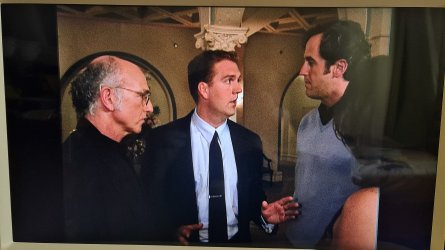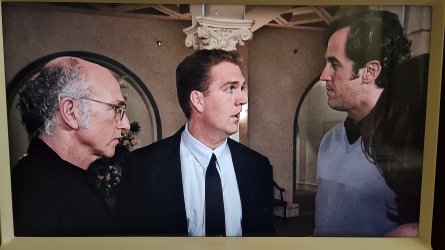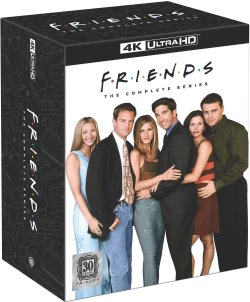Last edited:
Friends: The Complete Series - 30th Anniversary (1994-2004) (4K UHD Box Set) [USA]
- Thread starter paulboland
- Start date
You are using an out of date browser. It may not display this or other websites correctly.
You should upgrade or use an alternative browser.
You should upgrade or use an alternative browser.
Meanwhile- the BETTER show from the era, SEINFELD, not even on blu ray. This is way out of whack.
Curb Your Enthusiasm either.Meanwhile- the BETTER show from the era, SEINFELD, not even on blu ray. This is way out of whack.
After watching the first 6 seasons on my DVDs, those that were in 4:3, and on streaming are cut off on top and bottom, now downloading seasons 7 onward in 1080p because they're not available on Blu-ray.
Definitely! Gotta love Kramer.Meanwhile- the BETTER show from the era, SEINFELD, not even on blu ray. This is way out of whack.


Cropping 4:3 is as heinous a crime as panning and scanning 2.35:1Curb Your Enthusiasm either.
After watching the first 6 seasons on my DVDs, those that were in 4:3, and on streaming are cut off on top and bottom, now downloading seasons 7 onward in 1080p because they're not available on Blu-ray.
Who’s cropping 4:3?Cropping 4:3 is as heinous a crime as panning and scanning 2.35:1
In order to make 4:3 shows 16:9 they have to zoom in and crop the 4:3 imageWho’s cropping 4:3?
Here's a couple quick ugly photos for comparison. It's not only crowded and you're losing a big part of the picture, but the security guard in this scene actively gesticulates, and in a cropped streaming version you only see his head move 'strangely'.Who’s cropping 4:3?


The colors are also worse, and even the resolution/quality isn't higher, than on DVD, at least in the first few seasons.
It does look proper HD once they switched to widescreen in S7.
The digital resolution of standard 35mm film is 4K, while the digital resolution of 35mm film that is shot for IMAX is 6K. There is also 12K digital resolution for 70MM film that is shot for IMAX. A TV show like Friends would have obviously been shot on standard 35mm film (4K). In case anyone is curious, some TV shows were shot on 16MM film (2K), but 35MM (4K) is more typical.Anything shot on 35mm will yield 4-6K of resolution.
I'm still stunned they have re-scanned the 35mm negative of 10 seasons of Friends over the cheaper upscale 2k DI option... especially as the average consumer of Friends will not a have a clue around the difference.
True 4k is alive and well.
True 4k is alive and well.
That’s how some do it, but that isn’t how Friends was reframed. They just used parts of the frame that weren’t used for 4:3.In order to make 4:3 shows 16:9 they have to zoom in and crop the 4:3 image
View attachment 579025
I was talking about friends. Friends achieved 16:9 by adding parts of the frame tht weren’t originally used. The downside is in some cases there are things seen that shouldn’t be seen, like an unfinished part of the set, but I don’t recall noticing many of those when I watched several years ago.Here's a couple quick ugly photos for comparison. It's not only crowded and you're losing a big part of the picture, but the security guard in this scene actively gesticulates, and in a cropped streaming version you only see his head move 'strangely'.
View attachment 579051
View attachment 579052
The colors are also worse, and even the resolution/quality isn't higher, than on DVD, at least in the first few seasons.
It does look proper HD once they switched to widescreen in S7.
Film has latitude- unlike digital. Which is why 35mm can yield 4K-6K. 70mm can yield up to 18K of resolution.The digital resolution of standard 35mm film is 4K, while the digital resolution of 35mm film that is shot for IMAX is 6K. There is also 12K digital resolution for 70MM film that is shot for IMAX. A TV show like Friends would have obviously been shot on standard 35mm film (4K). In case anyone is curious, some TV shows were shot on 16MM film (2K), but 35MM (4K) is more typical.
This is true. They opened up the "tv-safe action area" for the 16:9 versions. The hope was that for a 4K blu ray version they would simply use OAR for the entire series.I was talking about friends. Friends achieved 16:9 by adding parts of the frame tht weren’t originally used. The downside is in some cases there are things seen that shouldn’t be seen, like an unfinished part of the set, but I don’t recall noticing many of those when I watched several years ago.
Of course, opening up the frame has it's own issues. Just like cropping, opening up the frame completely changes the composition of the shots. It creates "empty space" on either side. Even if they digitally paint out things that were not meant to be seen- the compostion and framing still ends up completely different from the original intention.
True, but going above 4k is not optimal as the footage will be visibly more grainy, noisy and less sharp - but you could over process the footage like James Cameron did recently and remove some of the natural grain/noise. Some people have blown up 16mm film, but the footage is very noisy. The Texas Chainsaw Massacre is a good example of a 16mm film that was blown up to 35mm and digitally transferred as a 4K file. The grainy footage does add to the look, though.Film has latitude- unlike digital. Which is why 35mm can yield 4K-6K. 70mm can yield up to 18K of resolution.
I do remember reading a book for a cinematography class in film school where the author had the opinion that the optimal resolution of 35MM is actually closer to 3.5K as the footage looks cleaner and sharper at that resolution when compared to 4K. Even when we look at photography, the images always look cleaner and sharper if we lower the resolution a bit. So my only point was that for optimal visual quality, 35MM film is generally best at 4K when compared to 6K.
Last edited:
There are many factors involved in getting an optimum transfer. What was the film stock? How fast were the lenses used? Was it slow or fast stock? Are you using OCN or IP?True, but going above 4k is not optimal as the footage will be visibly more grainy, noisy and less sharp - but you could over process the footage like James Cameron did recently and remove some of the natural grain/noise. Some people have blown up 16mm film, but the footage is very noisy. The Texas Chainsaw Massacre is a good example of a 16mm film that was blown up to 35mm and digitally transferred as a 4K file. The grainy footage does add to the look, though.
I do remember reading a book for a cinematography class in film school where the author had the opinion that the optimal resolution of 35MM is actually closer to 3.5K as the footage looks cleaner and sharper at that resolution when compared to 4K. Even when we look at photography, the images always look cleaner and sharper if we lower the resolution a bit. So my only point was that for optimal visual quality, 35MM film is generally best at 4K when compared to 6K.
Certainly there are some 35mm films that would be more diffucult to extract 4K latitude (Techniscope films that halved the 35mm frame), while some stocks look glorious with an 8k scan. (2001 A Space Odyssey, Lawrence of Arabia, Wizard of Oz were 8K scans). that's the great thing about film is that it has such latitude.
But there are certainly cases where the technicians involved felt that a negative could not yield more than 2 or 3K based on the condition of the negative.
As far as the Cameron Blu rays go- I am convinced that these are AI upscales of old 2K scans. I have worked with AI upscaling, and it has many of the telltale signs of a 2K upscale. I am also convinced that they did 100% grain removal and then added a smidgen of fake digital grain. Why he would not order a new scan from the Original Camera Negative is beyond me. A true 4K scan of the negatives would not have needed any AI enhancement.
2001 and Lawrence were printed on 70mm film, that's why they scanned them in so called 8K.Certainly there are some 35mm films that would be more diffucult to extract 4K latitude (Techniscope films that halved the 35mm frame), while some stocks look glorious with an 8k scan. (2001 A Space Odyssey, Lawrence of Arabia, Wizard of Oz were 8K scans).
2001 and Lawrence were shot on 65mm (Eastman Color Negative 50T 5251), Wizard of Oz on 35mm (3-strip technicolor). The films were scanned in 8k.2001 and Lawrence were printed on 70mm film, that's why they scanned them in so called 8K.
(The 65mm negatives could yield up to 12k)
Right, shot on 65mm, printed, as I wrote, on 70mm stock. Either way they're much different from 35mm for you to mention them as examples, was my point.2001 and Lawrence were shot on 65mm (Eastman Color Negative 50T 5251), Wizard of Oz on 35mm (3-strip technicolor). The films were scanned in 8k.
(The 65mm negatives could yield up to 12k)
Wizard of oz was on 35mm and transfered in 8k. You missed that part.Right, shot on 65mm, printed, as I wrote, on 70mm stock. Either way they're much different from 35mm for you to mention them as examples, was my point.
The point is that given specific 35mm negatuves can yeild more latitude than other 35mm negatives. Wizard of Oz was one such case where the 35mm neg yielded much more than 4k because of it being 3 strip technicolor.
Similar threads
- Replies
- 0
- Views
- 211
- Replies
- 2
- Views
- 364
- Replies
- 1
- Views
- 294
- Replies
- 4
- Views
- 560
